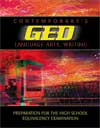To see if you are ready for the actual GED Language Arts, Writing Test, use the conversion chart below to determine your GED score. Count the number of questions you answered correctly on Part I of the test and find that number in the left-hand column. Then find your GED essay score across the top of the chart. Read across and down to find the combined GED standard score. Remember that you must score 2 or above on the essay to pass the Language Arts, Writing Test. Correct Answers | Averaged Essay Score |
| 2 | 2.5 | 3 | 3.5 | 4 | | 25 | 630 | 670 | 710 | 750 | 800 | | 24 | 550 | 590 | 630 | 660 | 720 | | 23 | 500 | 540 | 580 | 610 | 660 | | 22 | 480 | 520 | 550 | 590 | 650 | | 21 | 470 | 500 | 540 | 570 | 630 | | 20 | 460 | 490 | 530 | 560 | 620 | | 19 | 450 | 480 | 520 | 550 | 610 | | 18 | 440 | 470 | 510 | 550 | 600 | | 17 | 430 | 460 | 500 | 540 | 590 | | 16 | 420 | 460 | 490 | 530 | 590 | | 15 | 410 | 450 | 490 | 520 | 580 | | 14 | 400 | 450 | 480 | 520 | 570 | | 13 | 400 | 440 | 480 | 510 | 570 | | 12 | 390 | 440 | 470 | 510 | 560 | | 11 | 390 | 430 | 470 | 500 | 560 | | 10 | 380 | 430 | 460 | 500 | 550 | | 9 | 380 | 420 | 450 | 490 | 550 | | 8 | 370 | 410 | 440 | 490 | 540 | | 7 | 370 | 400 | 440 | 480 | 530 | | 6 | 360 | 390 | 430 | 470 | 530 | | 5 | 350 | 380 | 420 | 460 | 520 | | 4 | 340 | 370 | 410 | 450 | 500 | | 3 | 310 | 350 | 380 | 410 | 460 | | 2 | 260 | 300 | 330 | 370 | 410 | | 1 | 220 | 260 | 300 | 340 | 380 |
The minimum score requirement for the Language Arts, Writing Test is 410. A standard score that is at or below the minimum indicates that more study is needed before taking the Language Arts, Writing Test. Use the following chart to determine the areas you need to review before taking the test. Make note of any items you answered incorrectly and find them in the chart. Pay particular attention to areas where you missed half or more of the questions. For those questions that you missed, review the indicated skill pages in Contemporary's GED Language Arts, Writing. Content Area | Item Number | | ORGANIZATION | | Topic Sentences
(see pages 115–119) | 20 | Unity/Coherence
(see pages 127–133) | 10, 13 | | SENTENCE STRUCTURE | | Complete Sentences, Fragments, and Sentence Combining
(see pages 19–24, 83–104) | 15 | Run-on Sentences/Comma Splices
(see pages 86–88, 96) | 5, 8 | Wordiness/Repetition
(see pages 97, 98, 103, 104) | 17 | Coordination/Subordination
(see pages 83, 84, 89–98) | 19, 23 | Parallelism
(see pages 154–156) | 1 | | USAGE | | Subject-Verb Agreement
(see pages 51–59, 62–73) | 2, 9, 14, 21 | Verb Tense/Form
(see pages 51–61, 101, 102) | 18, 24 | Pronoun Reference/Antecedent Agreement
(see pages 38–42, 157–165) | 6, 11, 16 | | MECHANICS | | Capitalization
(see pages 29, 34, 35, 177, 178) | 3, 12 | Punctuation (commas)
(see pages 31, 87, 93, 96, 183–185) | 4, 7, 25 | Spelling (possessives, contractions, and homonyms)
(see pages 43, 179–182) | 22 |
|



 2002 McGraw-Hill Higher Education
2002 McGraw-Hill Higher Education